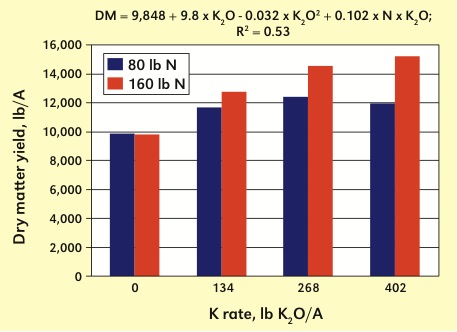Bermudagrass is an important summer perennial for both grazing and hay production, and has been a part of southern agriculture for at least 250 years. Its desirable characteristics include high yield potential, drought resistance, and a degree of soil acidity tolerance. Hybrid bermudagrass is generally more productive than common. Coastal, introduced in 1943, has been the standard hybrid over much of the southern US; however, other hybrids such as Tifton 85 have made significant inroads over the past few years.
Bermudagrass is highly responsive to nitrogen (N) fertilization, but it also requires considerable amounts of available potassium (K). According to the International Plant Nutrition Institute’s (IPNI) latest figures, each ton of bermudagrass hay removes about 46 lb N and 50 lb K₂O. So for a modest 5 ton/A annual hay yield, 250 lb K₂O will be exported from the field. Therefore, it stands to reason that without adequate fertilizer input soil K can be rapidly depleted under bermudagrass hay production, especially in course-textured soils with limited K reserves. This was demonstrated in an east Texas study where on two sandy soils the level of soil test K in the controls was decreased to about one-third the initial levels—from 160 to 50 ppm—after three years of Coastal bermudagrass production. This study also showed that application of up to 300 lb K₂O/A/year could not maintain the original soil K levels (Nelson et al., 1983).
Potassium nutrition can have a substantial impact on bermudagrass stand density, which in turn affects other important production factors such as weed encroachment and stand longevity. Stand deterioration is frequently attributed to winterkill, disease pressure, and lack of “physiological hardening”—all factors that to some degree can be associated with K nutrition. Rhizome and root production and health are impacted by K nutrition. The amount of rhizomes and the associated stored energy reserves are important factors in stand maintenance and the regeneration of top growth.
Potassium fertility has long been known to interact with N nutrition in crop production. To get the most out of N fertilizer inputs it is necessary to have an adequate supply of available K. A study on Tifton 85 bermudagrass has helped demonstrated this fundamental principle (Figure 1). Notice in the figure that addition of some K improved yield response to N at the lower N rate, thereby implying an improvement in recovery of applied N (actual efficiencies were not directly measured). This effect was not observed beyond the first increment of K at the lower N rate. However, at the higher N rate there was a yield benefit to the higher levels of K. This interactive effect shows that K input can have a substantial influence on the effectiveness of applied N, and for that matter other inputs including available water.

Figure 1. Effect of N and K rate on Tifton 85 bermudagrass yield in 2004 (Overton, TX; from Haby et al., 2008).
For any crop production system to function at optimal efficiency complete and balanced fertility is essential. Considering that cattle prices are strong, and as one recent headline read “’Exceptional’ year ahead for cattle market” ( Ag web/Farm Journal), it’s a good time to make sure that bermudagrass and other forage crops do not go into the spring short of needed K fertility.